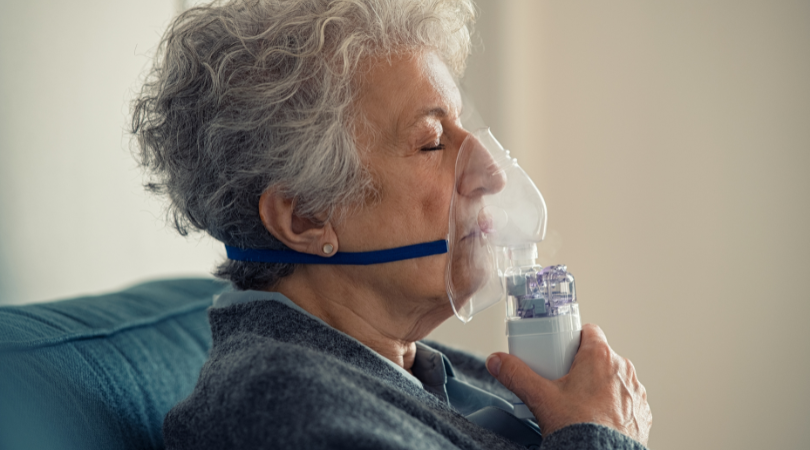Understanding & Treating Dyspnea

Dyspnea is the sensation of uncomfortable breathing or difficulty in breathing. Over 50% of patients with serious illness report experiencing dyspnea – and it’s the fourth most common reason for a visit to the emergency room.
Patients may describe it as “I can’t catch my breath,” “My chest feels tight,” or “It feels hard to breathe.”
Assessing Dyspnea in Patients
Assessments are the cornerstone of quality care. When a patient reports dyspnea, we need to ask questions to get a better understanding of the patient’s symptoms. The questions should cover:
- Onset – When did it begin? How long does it last? How often does it occur?
- Provoking/Palliating – What brings it on? What makes it better? What makes it worse?
- Quality – What does it feel like? Can you describe it?
- Religion/Radiation – Are there any other associated symptoms?
- Severity – What is the intensity of this symptom? (On a scale of 0 to 10 with 0 being none and 10 being the worst possible)? Right now? At best? At worst? On average? How bothered are you by this symptom? Are there any other symptoms that accompany this symptom?
- Treatment – What medications or treatments are you currently using? How effective are these? Do you have side effects from the medications/treatments? What medications/treatments have you used in the past?
- Understanding / Impact on You – What do you believe is causing this symptom? How is this symptom affecting you and/or your family?
- Values – What is your goal for this symptom? What is your comfort goal or acceptable level for this symptom (on a scale of zero to ten with zero being none and ten being the worst possible)? Are there any other views or feelings about this symptom that are important to you or your family?1
Patients should also receive a physical assessment as appropriate for the symptoms and pertinent family history should be reviewed for risk factors.

Treatment of Dyspnea
Once we have completed our assessment, we first want to tackle the treatable underlying causes. Some of these could be: COPD, pneumonia, pleural effusion, anemia, ascites, Afib, angina pectoris, etc.
Next, we move on to our nonpharmacologic approaches. Dyspnea can be scary for both the patient and the caregiver. These approaches are great education points for prevention and patients should be encouraged to incorporate them into daily practices.
- Positioning: Suggest positions that maximize respiratory function with a reduction in physical effort. This is usually an upright position, if attainable.
- Breathing techniques: Pursed breathing and diaphragmatic breathing.
- Hand-held fan: Airflow directed at the nose/mouth alters ventilation and reduces breathlessness.
- Environment: Avoid and eliminate strong odors, fumes, and smoke.
- Relaxation techniques: Use of music, meditation, acupuncture, and acupressure.
- Address anxiety and panic: Hospice social workers and chaplains can provide psychosocial support to help address issues causing anxiety and panic, whether it be from isolation, spiritual concerns, or addressing fears.
- Respond: Identify situational triggers and create a response plan.
Even if a pharmacological therapy is added, all of the above therapies can complement that medication.
Oxygen is a common treatment for breathlessness, and it is absolutely indicated for patients with chronic hypoxemia. In the absence of hypoxemia, opioid or fan therapy may be able to address the symptoms without the need for oxygen therapy.
Opioids are another important treatment option for dyspnea. Although most of the studies use morphine, a wide variety of opioids can be used for dyspnea including oral morphine, oxycodone, and hydromorphone with no studies showing one opioid better than another. They are the first-line pharmacological treatment for dyspnea. We have opioid receptors all over in our central and peripheral nervous system, including the lung. Opioids should be considered if the non-pharmacological methodologies bring inadequate relief.
If a patient is already on a long-acting opioid, a nurse may adjust their dosage to treat the breakthrough symptoms. Regular low-dose long-acting opioids can be safe and effective for dyspnea in patients with advanced illness. However, opioids are not appropriate for mild, intermittent dyspnea (for example: mobility induced dyspnea) since any benefit will be limited by the time of onset of effect.
When introducing an opioid or increasing the dose, it is important to monitor for side effects. Constipation is a particular concern when using opioids, so patients must have a bowel regimen in place.
DiGi Graham, Doctor of Pharmacy
Chief Corporate Pharmacist
Crossroads Hospice & Palliative Care
Crossroads Hospice & Palliative Care supports patients with serious and terminal illness. To learn more about our services, please call 1-888-564-3405.
References:
- Cancer Care Ontario. Cancer Care Ontario's Symptom Management Guide-to-Practice: Dyspnea. https://www.cancercareontario.ca/system/files_force/symptoms/CCODyspneaFull.pdf. Published August 2010. Accessed September 1, 2022.
- Shega JW, Paniagua MA. UNIPAC Book 4, Nonpain Symptom Management, Essential Practices in Hospice and Palliative Medicine. 5th edition. Chicago: American Academy of Hospice and Palliative Medicine; 2016.
- Bruera E, Higginson I, Von Gunten CF, Morita T. Textbook of Palliative Medicine. Second edition. CRC Press; 2015. Accessed August 29, 2022.
If you found this information helpful, please share it with your network and community.
Copyright © 2022 Crossroads Hospice. All rights reserved.




